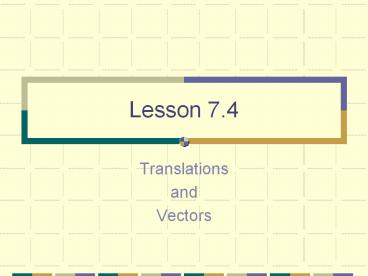Translations PowerPoint PPT Presentation
Title: Translations
1
Lesson 7.4
- Translations
- and
- Vectors
2
Lesson 7.4
- Define a translation
- Identify a translation in a plane
- Use vectors to describe a translation
- Identify vector notation
3
Translation Definition
- A translation is a transformation that maps an
object by shifting or sliding the object and all
of its parts in a straight light. - A translation must also move the entire object
the same distance.
4
Theorem 7.4Translation Theorem
- A translation is an isometry.
5
Theorem 7.5Distance of Translation Theorem
- If lines k and m are parallel, then a reflection
in line k followed by a reflection in line m is a
translation. - The segment between P and P is perpendicular to
k and m. - The distance of the translation is twice the
distance between the reflecting lines.
x
2x
6
Coordinate form
- Every translation has a horizontal movement and a
vertical movement. - A translation can be described in coordinate
notation. - (x,y) ? (xa , yb)
- Which tells you to move a units horizontal and b
units vertical.
Q
b units up
P
a units to the right
7
Vectors
- Another way to describe a translation is to use a
vector. - A vector is a quantity that shows both direction
and magnitude, or size. - It is represented by an arrow pointing from
pre-image to image. - The starting point at the pre-image is called the
initial point. - The ending point at the image is called the
terminal point.
8
Component Form of Vectors
- Component form of a vector is a way of combining
the individual movements of a vector into a more
simple form. - ?x , y?
- Naming a vector is the same as naming a ray.
- PQ
Q
y units up
P
x units to the right
9
Use of Vectors
- Adding/subtracting vectors
- Add/subtract x values and then add y values
- ?2 , 6? ?3 , -4?
- ?5 , 2?
- Distributive property of vectors
- Multiply each component by the constant
- 5 ?3 , -4?
- ?15 , -20?
- Length of vector
- Pythagorean Theorem
- x2 y2 length2
- Direction of vector
- Inverse tangent
- tan-1 (y/x)
PowerShow.com is a leading presentation sharing website. It has millions of presentations already uploaded and available with 1,000s more being uploaded by its users every day. Whatever your area of interest, here you’ll be able to find and view presentations you’ll love and possibly download. And, best of all, it is completely free and easy to use.
You might even have a presentation you’d like to share with others. If so, just upload it to PowerShow.com. We’ll convert it to an HTML5 slideshow that includes all the media types you’ve already added: audio, video, music, pictures, animations and transition effects. Then you can share it with your target audience as well as PowerShow.com’s millions of monthly visitors. And, again, it’s all free.
About the Developers
PowerShow.com is brought to you by CrystalGraphics, the award-winning developer and market-leading publisher of rich-media enhancement products for presentations. Our product offerings include millions of PowerPoint templates, diagrams, animated 3D characters and more.

